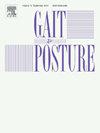Obesity as a moderator of lumber spine posture change during pregnancy
IF 2.4
3区 医学
Q3 NEUROSCIENCES
引用次数: 0
Abstract
Background
Low back pain is one of the most common orthopedic issues during pregnancy, sometimes linked to a “gestational lordosis” spine posture. The aims in this study were to explore how the lumbar spine changes, establish the relationship of lumbar curvature to torso anthropometry, and determine if anthropometry can be used to predict lumbar angle changes during pregnancy.
Methods
Anthropometry and comfortable standing spine curvature were measured longitudinally during the last seven months of pregnancy of eleven pregnant participants. Multiple regression analyses were used to determine correlates at each time point. Auto- and cross-correlations were used to determine predictors of lumbar spine curvature.
Results
Comfortable standing lumbar spine curvature was not correlated with gestational time (r2 ≤ 0.031) and did not have a high autocorrelation indicating the inappropriateness to assume a single lumbar spine postural change during pregnancy. However. lumbar curvature was correlated with individual anthropometry (r2 = 0.489) and those same measures can be used to predict lumbar posture change between the 1st trimester and the 3rd trimester of pregnancy.
Significance
Findings from this study can be applied to better predict pregnancy spine posture based on unique abdominal size increases relative to body size. Clinicians can use measures related to pre-pregnancy body mass index and torso mass gains to plan for ergonomic device use and work accommodation plans. Musculoskeletal models should consider that lower and higher BMI individuals may present with different loading patterns due to differences in lumbar spine posture change.
肥胖对孕期腰椎姿势改变的调节作用
背景:腰痛是孕期最常见的骨科问题之一,有时与“妊娠期脊柱前凸”有关。本研究的目的是探讨腰椎如何变化,建立腰椎曲度与躯干人体测量的关系,并确定人体测量是否可以用于预测怀孕期间腰椎角度的变化。方法对11例孕妇在妊娠后期7个月进行纵向测量。采用多元回归分析确定各时间点的相关性。自相关性和相互相关性被用来确定腰椎弯曲的预测因子。结果站立时腰椎弯曲舒适度与妊娠时间无相关性(r2≤0.031),且自相关性不高,提示妊娠期单腰椎体位改变不合适。然而。腰椎曲度与个体人体测量相关(r2 = 0.489),这些测量可用于预测妊娠早期和晚期腰椎姿势的变化。意义:本研究结果可用于更好地预测孕妇的脊柱姿势,基于独特的腹部尺寸相对于身体尺寸的增加。临床医生可以使用与孕前身体质量指数和躯干质量增加相关的措施来计划人体工程学设备的使用和工作住宿计划。肌肉骨骼模型应考虑到,由于腰椎姿势变化的差异,低BMI和高BMI个体可能呈现不同的负荷模式。
本文章由计算机程序翻译,如有差异,请以英文原文为准。
求助全文
约1分钟内获得全文
求助全文
来源期刊

Gait & posture
医学-神经科学
CiteScore
4.70
自引率
12.50%
发文量
616
审稿时长
6 months
期刊介绍:
Gait & Posture is a vehicle for the publication of up-to-date basic and clinical research on all aspects of locomotion and balance.
The topics covered include: Techniques for the measurement of gait and posture, and the standardization of results presentation; Studies of normal and pathological gait; Treatment of gait and postural abnormalities; Biomechanical and theoretical approaches to gait and posture; Mathematical models of joint and muscle mechanics; Neurological and musculoskeletal function in gait and posture; The evolution of upright posture and bipedal locomotion; Adaptations of carrying loads, walking on uneven surfaces, climbing stairs etc; spinal biomechanics only if they are directly related to gait and/or posture and are of general interest to our readers; The effect of aging and development on gait and posture; Psychological and cultural aspects of gait; Patient education.
 求助内容:
求助内容: 应助结果提醒方式:
应助结果提醒方式:


